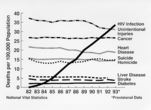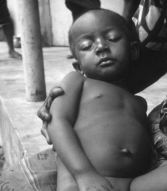|
The History of AIDS
Endeavoring to raise AIDS awareness through understanding.
<< History of AIDS last page || History of AIDS next page >>
1981: The Beginning
In 1981, the first cases of AIDS (Acquired Immune Deficiency Syndrome) were identified
among gay men in the United States, acquiring the designation, GRID (Gay-Related
|

By the end of 2003, twelve million children in
Sub-Saharan Africa were orphaned by AIDS.
Source: AVERT.ORG
Image Source: CDC/Dr. Lyle Conrad
|
Immune Deficiency); however, scientists later found evidence that
the disease existed in the world for some years prior, i.e., subsequent analysis
of a blood sample of a Bantu man, who died of an unidentified illness in the Belgian
Congo in 1959, made him the first confirmed case of an HIV infection. Source:
CNN In an article, "1959 and all that:
Immunodeficiency viruses," by Simon Wain-Hobson of the Pasteur Institute in
Nature (Volume 391, 5 February 1998, pp. 532-533), Wain-Hobson wrote: "Where
did HIV [Human Immunodeficiency Virus] come from? Both of the AIDS viruses, HIV-1
and HIV-2, originated in Africa... As is often the case with microbes, a jump from
one species to another is probably to blame... chimpanzees (for HIV-1) and sooty
mangabeys (for HIV-2)... When did the AIDS epidemic begin?... the Big Bang seems
to have occurred around, or just after, the Second World War. Emerging microbial
infections often result from adaption to changing ecological niches and habitats."
Cases of Pneumocystis carinii pneumonia (PCP, a lung infection) and Kaposi's sarcoma
(a rare skin cancer) were reported by doctors in New York and Los Angeles in 1981,
then the Centers for Disease Control and Prevention (CDC) began tracking a growing
population of young men, women, and babies, whose immune systems were nearly destroyed.
Late in 1982, the condition began to be referred to as AIDS. Source: American
Red Cross For a few at first, their awareness of AIDS
began with the publishing of a little noticed entry on page two of the CDC's Morbidity
and Mortality Weekly Report of June 5, 1981, where a strange outbreak of killer
pneumonia was spreading among gay men. Since this report, AIDS has graduated from
a seemingly local phenomenon to a global epidemic. Source: CNN
1982-1985: The Faces of AIDS
Cases of AIDS in 1982 began to be reported by fourteen nations. And, as early
as 1982, CDC received its first report of "AIDS in a person with hemophilia
(from a blood transfusion), and in infants born to mothers with AIDS." Source:
CDC Historical Highlights A contemporary
update on this, concerning AIDS and blood transfusions, from the American Red Cross:
"Like most medical procedures, blood transfusions have associated risk. In the
more than fifteen years since March 1985, when the FDA first licensed a test to detect
HIV antibodies in donated blood, the Centers for Disease Control and Prevention has
reported only 41 cases of AIDS caused by transfusion of blood that tested negative
for the AIDS virus. During this time, more than 216 million blood components were
transfused in the United States... Scientific studies have proven that volunteer
donors are the single greatest safeguard of the blood supply today." Source:
Myths About AIDS and the Blood Supply To
continue, Dr. Luc Montagnier of the Pasteur Institute in France announced the isolation
of the LAV retrovirus (lymphadenopathy-associated virus) in 1983, which later was
identified as the cause of AIDS. Source: CNN By 1983, 33 countries reported cases
of AIDS. And, on the other side of the Atlantic, Dr. Robert Gallo of the National
Cancer Institute isolated the HTLV-III (Human T-Cell Lymphotropic Virus III) retrovirus
in 1984. Medical periodicals such as
|

Leading causes of AIDS related deaths in the USA.
Image Source: Wikimedia
|
The Journal of the American Medical Association (JAMA) continued
to reference HTLV-III as the "primary etiologic agent of the acquired immunodeficiency
syndrome (AIDS)" as late as 1985. Source: JAMA However, in 1986, it was determined
that HTLV-III and LAV were the same virus, and they were given the new designation
of Human Immunodeficiency Virus or HIV. AIDS awareness was soon brought to the public's
consciousness, when popular film star, Rock Hudson, died of AIDS on October 2, 1985,
shortly after making public his AIDS on July 25, 1985, thus becoming the first major
public figure to announce that he had AIDS. Another entertainer, the pianist Liberace
died of AIDS on February 4, 1987. Many other well known personalities from the entertainment
industry added their familiar faces to the cumulative weight of the AIDS crisis,
when they succumbed to AIDS: (1) Amanda Blake (Miss Kitty of Gunsmoke) died
in 1989 of AIDS related throat cancer, (2) Anthony Perkins (Norman Bates of Hitchcock's
Psycho) died in 1992 of pneumonia brought on by AIDS, (3) Robert Reed (Mike
Brady of The Brady Bunch) died in 1992 of intestinal cancer and complications
of AIDS, and (4) Dack Rambo (Jack Ewing of Dallas) died in 1994 of complications
of AIDS. What are the complications of AIDS? Any secondary condition, symptom, or
other disorder caused by an AIDS weakened immune system is a complication of AIDS,
so that any number of opportunistic infections can take advantage of that weakness.
An opportunistic infection (OI) occurs, when the germs normally in our body take
advantage of the weakness of the immune system to cause health problems. If you have
HIV and any of a list of about 24 designated Center for Disease Control opportunistic
infections, then you have AIDS. Some of the more common opportunistic infections
in conjunction with HIV are: (1) PCP (Pneumocystis pneumonia), (2) KS (Kaposi's sarcoma),
(3) CMV (Cytomegalovirus, an infection usually affecting the eyes), (4) Candidiasis
(Thrush: an infection of the mouth, throat, or vagina), (5) Mycobacterium tuberculosis
(TB), and (6) Herpes simplex (can cause oral herpes or genital herpes). Source:
New Mexico AIDS InfoNet
<< History of AIDS last page || History of AIDS next page >>
The History of AIDS © 2005
Legal Disclaimer: "The History of AIDS" is not affiliated
in any way with the organizations, or third party links found at this website, with
the exception of links to Amazon.com. The information at this website should not
be taken as medical advice, treatment, or diagnosis, express or implied. Even though
a reasonable effort has been made to present correct information, no warranty is
made that the data at this website is true or accurate. Consult your health care
professional before beginning ANY treatment or regimen.
Member of Fohn.net
Privacy Policy
|


